Overview
Within This Page
Elementary School buildings are the setting for the first four to eight years of a child's formal education, a period of structured schooling that is compulsory in most countries. In the United States, the Elementary and Secondary Education Act (ESEA), first enacted in 1965 and reauthorized by the No Child Left Behind Act, is the principal federal law that affects kindergarten through 12th grade (K–12). Elementary school usually begins for children aged four to seven (four if the school includes kindergarten, which is a program for children four to six years of age that serves as an introduction to school). Other terms used to describe this initial stage of education are "primary", "grade" and "grammar" school. This Building Type page defines elementary school as grades K-8.
More than other building types, school facilities have a profound impact on their occupants and the functions of the building, namely teaching and learning. Children in various stages of development are stimulated by light, color, the scale of their surroundings, even the navigational aspects of their school. Children can also react negatively to adverse conditions.
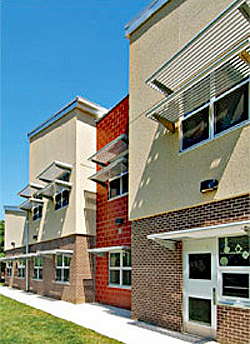
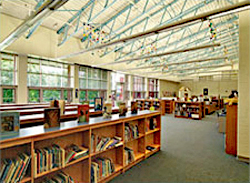
Passive solar design strategy incorporated into the exterior of the building.
Photo Credit: Loan Pham
The Library / Media Room receives ample daylight.
Photo Credit: Duane Lempke / Sisson Studios
Glebe Elementary School, Arlington, Virginia. Designed by BeeryRio Architecture + Interiors
Building Attributes
Elementary schools can be designed in a variety of sizes, configurations, and layouts depending on the school district and the program. It is fairly common for grades seven and eight—sometimes six, seven and eight—to be housed in separate facilities as "middle schools." Middle schools pose special challenges to designers. Students at this pre-adolescent age are becoming more independent, experimental, and temperamental. They have transitioned from primary school, where instruction occurs for the most part in one classroom with one teacher, and are learning to follow schedules and find their way to different parts of the building. The physical organization of the school needs to provide easy navigation that builds confidence without sacrificing safety and security. Middle schools also require space for lockers, science labs, art studios, industrial arts, choral and band, and other programs. Media centers, often as large as 4,000 to 5,000 square feet, are more sophisticated and frequently used in middle schools. Middle school teachers value cross-disciplinary team teaching, which typically requires spacious, flexible facilities. For these reasons, and to separate young children from older students, primary and middle school spaces must be delineated.
Regardless of the school's configuration, children need a healthful and stimulating environment in which to learn. Elementary schools should be comfortable visually, acoustically, and thermally; they should have excellent indoor air quality; and they should be safe and secure. These buildings should also be also good environmental citizens as they are teaching tools in and of themselves. Community leaders, parents, and educators value schools that have a strong connection to the community. And finally, elementary schools need to be cost effective in order to maximize limited funding and provide the best learning environments possible for the budget.
A. Types of Spaces
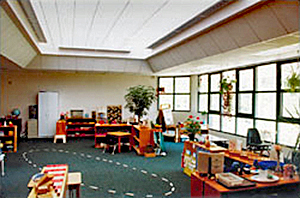
The roof monitors that bring daylight into the classrooms of this 200–student elementary school provides an added benefit: improved acoustics.
Sterling Montessori Academy, Morrisville, North Carolina.
Fundamental space types for elementary schools include, but are not limited to:
- Administrative Offices
- Art facility
- Cafeteria — In elementary schools, the cafeteria often doubles as the auditorium, aka "cafetorium."
- Classroom — Daylighting is most important in classrooms, where most teaching and learning occurs.
- Common areas /courtyards
- Gymnasium
- Health Services
- Lobby — Schools often showcase team trophies in the foyer or feature a colorful display at child's eye level.
- Media Center — Schools are changing traditional libraries into media centers, adapting to new technology, as well as to other issues such as comfort, flexibility and maximum use of space.
- Multipurpose Rooms
- Music Education
- Restrooms
- Science Facility
B. Important Design Considerations
Accessibility
-
Design spaces to meet the specific needs of students, teachers, and administrative staff with disabilities. See Americans with Disabilities Act Accessibility Guidelines (ADAAG).
- The United States Access Board, which supports ADA implementation, recognizes that poor acoustics also have a negative impact on hearing-impaired students. Acoustical Society of America has published two American National Standards on classroom acoustics:
- Design for future flexibility, which enables spaces to be easily modified.
See also:
- ADA Accessibility Guidelines for Play Areas
- ADA Accessibility Guidelines for Building Elements Designed for Children's Use
- WBDG Beyond Accessibility to Universal Design
Aesthetics
The importance of the physical appearance of a public school should not be minimized. A school building that is attractive and responds to and is consistent with the design and context of the neighborhood, builds a sense of pride and ownership among students, teachers, and the community. The exterior should complement the neighborhood and reflect the community's values. The interior should enhance the learning process.
- Bring the community into the planning process through an integrated design process.
- Provide an interior environment that is visually comfortable and stimulating by integrating natural and artificial lighting, eliminating glare, and incorporating colors that stimulate or soothe, depending on the space function.
- Design for diffuse, uniform daylight throughout classrooms.
- Avoid direct-beam sunlight.
- Use a daylighting analysis tool to integrate lighting systems, controls, and materials that reflect or absorb light.
Cost-Effective
School districts typically separate their capital and operating budgets and therefore have little incentive to factor in the long-term cost of a building when making decisions about its design and construction. However, to reduce the total cost of owning a building while ensuring its quality, it is necessary to balance the initial design and construction costs with the cost of lighting, heating, cooling, repairing, and otherwise operating and maintaining the facility.
- Apply cost-effective principals in the planning, design, construction, and operation of school facilities.
- Select building elements on the basis of life-cycle cost analysis — Mirror the lifespan of projects and systems with the expected lifespan of the facility.
- Consider the recyclability of materials.
- Specify materials and products that are easy to maintain (balance this with their impact on children's health and the environment).
- Utilize life-cycle cost analysis tools.
- Commission the facility to ensure that it operates in a manner consistent with design intent.
- Use energy simulation and analysis tools to optimize energy performance (integrate daylighting systems, high-performance HVAC, energy-efficient building shell, and high-performance electric lighting)
Functional
To foster students' sense of community and individuality:
- Cluster classrooms around common areas.
- Connect spaces visually with colors and patterns, particularly for primary school children.
- Provide platform spaces for gathering, sitting, and presenting and alcoves for quiet play, reflection, and reading.
- Decentralize administrative spaces to encourage active leadership and maximize interaction with students.
- Provide a "home base" for each student and teacher.
To ensure flexibility and adaptability for changing programs and enrollments:
- Use operable walls to increase the efficiency of large, multi-purpose spaces, such as the cafeteria and gymnasium.
- Accommodate technology upgrades.
- Allow classrooms to change with the activity and group size. This is particularly important in primary schools, where students typically stay in one room with one teacher throughout much of the day.
Historic Preservation
Historic school buildings—those that are 50 years of age or older—were typically the centers of their communities and were designed to optimize natural ventilation and daylighting. Communities should study the history of their schools and become involved in the planning of new schools in order to make wise decisions regarding renovation versus new construction. All of the pros and cons of renovating an old school should be weighed, such as:
- Structural integrity
- Community access
- Building orientation-solar access
- Daylighting opportunities (i.e., large windows) and possible barriers (multi-story buildings)
- Other features that enhance or hinder visual/thermal/acoustic comfort
- Potential to upgrade for energy efficiency, water efficiency, safety and security, and technology
- Aesthetics
- Community landmark; historic significance
- Proximity to residential neighborhoods (potential for walking/bicycling to school)
- Site disturbance
For information about preserving, rehabilitating, restoring, or reconstructing historic buildings see WBDG Historic Preservation Branch.
Productive
Elementary schools should enhance the health and productivity of students, teachers, and staff.
- Make daylighting a priority, especially in classrooms. Daylighting is the controlled admission of natural light into a space. Glare and hot spots can undermine the learning process. Studies show a positive correlation between daylighting and student performance.
- Integrate daylighting with high-efficient electric lighting and controls to optimize visual comfort.
- Use natural ventilation when possible. (This and daylighting also provides a connection to the outdoors.)
- Ensure acoustical comfort. Poor classroom acoustics are more than merely annoying. If young children are unable to hear their teacher, they usually are unable to "fill in the blanks" as adults with life experience are able to do, and this can disrupt learning.
- Ensure superior indoor air quality. Children typically are more sensitive to indoor air pollutants than adults and more likely to suffer ill effects such as allergies and asthma. See the EPA's information on healthy school environments Healthy Schools, Healthy Kids. Consider displacement ventilation systems .
- Ensure thermal comfort. "Right size" HVAC systems to keep humidity in the comfort zone. Give teachers control over the temperature of individual classrooms.
- Embrace the concept of the building as a teaching tool (aka a 3-D textbook or living lab).
- Connect the indoor environment to the outdoors by providing operable view windows in classrooms and easy access from classrooms to gardens and other outdoor areas that can be utilized in the curriculum.
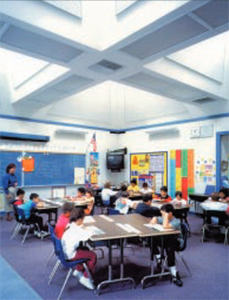
Skylights are used to distribute natural daylight to the classrooms, library, multipurpose room, and offices of this 800–student, K–5 school. Louvers installed in the skylight wells help control daylight levels and can be used to darken rooms when necessary. Classroom windows provide additional daylight and are protected by deep overhangs that control direct sunlight and glare.
Dena Boer Elementary School, Salida, California.
Secure / Safe
- Providing safe schools should be a high priority.
- Maximize visual access to corridors and school grounds.
- Increase occupants' sense of ownership and "territoriality" by providing comfortable, not institutional, rooms and by clearly defining the school boundaries.
- Control access to the building and grounds by individuals and vehicles.
- Use durable, non-toxic building materials.
- Provide shelter in cases of emergency. See BIPS 07 / FEMA 428 Primer to Design Safe School Projects in Case of Terrorist Attacks and School Shootings and FEMA Safe Rooms and Community Shelters Case Studies.
- Accommodate safe egress from the building in case of emergency.
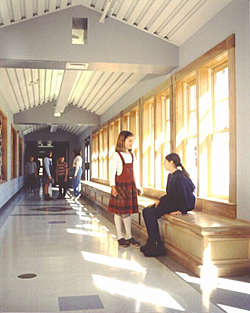
'Room like,' non-institutional corridors, plenty of views out and in, and windows between the classrooms and the hallway all combine to improve the safety and sense of security in this New Hampshire school.
Boscawen Elementary School, Boscawen, New Hampshire.
Sustainable
- Designing sustainable, high performance green schools.
- Use energy, water, and other resources efficiently.
- Integrate renewable energy strategies, including passive solar design and, where appropriate, solar thermal and photovoltaics.
- Integrate high-performance mechanical and lighting systems.
- Conserve and protect natural areas. Provide barriers that protect children and plants and wildlife.
- Incorporate materials and products derived from sustainable-yield processes and/or are manufactured locally.
- Provide opportunities for safe walking and bicycling to school.
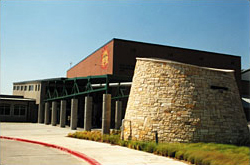
Rain is "harvested" from the roof of this 608–student, K–5 school, and used to water the grounds and flush the toilets year round. The water is stored in six above-ground cisterns designed as integral components of the overall architecture of the facility.
Roy Lee Walker Elementary School, McKinney, Texas, Independent School District.
Emerging Issues
Demand is on the rise for schools that feature high-performance design and technologies to enhance learning, support community use, and function well during natural and manmade disasters. At the same time, resources for school planning, design, construction, and operation are constrained. The challenge is to build high quality schools efficiently. Community shared spaces and life-cycle cost analysis are two ways that designers are meeting this challenge.
Scientists, planners, design professionals, public officials, school administrators, parents, teachers, and students are informing the current dialogue about optimal school design:
-
Scientists who study the "neuroscience of learning" are finding that certain lighting, acoustics, and spatial relationships support or hinder the learning process.
-
Planners and designers are involving community stakeholders in their design decisions and spurring the development of joint-use facilities that are centers of the community.
-
Concerns about safety and security (within the school and within the community) are more acute than ever, prompting innovative thinking about design strategies that minimize the impact of natural and manmade hazards. Schools with back-up, off-grid, renewable power systems can double as emergency shelters. See NREL Solar Secure Schools: Strategies and Guidelines .
-
State and local officials are recognizing that school facilities-the physical buildings-are important to their programmatic success. Several states have established new design guidelines and requirements for "high performance" schools whose features promote student/teacher health and productivity, cost-effectiveness, and sustainability.
-
School administrators, parents, teachers, and students are focused on meeting new testing standards, which calls for an enhanced learning environment with appropriate technology and comfort control systems.
-
School districts are serving communities that are increasingly multi-cultural and multi-lingual.
Relevant Codes and Standards
Federal Mandates and Criteria
- ADA Accessibility Guidelines for Play Areas
- ADA Accessibility Guidelines for Building Elements Designed for Children's Use
- Guide to the ADA Accessibility Guidelines for Play Areas
- DOD Education Activity (DODEA)—Education Facilities Specifications: Elementary School
- DOD Education Activity (DODEA)—Education Facilities Specifications: Middle School
- UFC 3-210-04 Children's Outdoor Play Area
- UFC 4-740-14 Design: Child Development Centers (USACE and Air Force Only)
- FC 4-740-14N Navy and Marine Corps Child Development Centers
- UFGS 11 68 13 Playground Equipment
- UFGS 32 18 16.13 Playground Protective Surfacing
Standards and Guidelines
- ANSI/ASA S12.60 Part 1 American National Standard Acoustical Performance Criteria, Design Requirements, and Guidelines for Schools, Part 1: Permanent Schools, Acoustical Society of America.
- ANSI/ASA S12.60 Part 2 American National Standard Acoustical Performance Criteria, Design Requirements, and Guidelines for Schools, Part 2: Relocatable Classroom FactorsAcoustical Society of America.
- ANSI/ASHRAE Standard 55 Thermal Environmental Conditions for Human Occupancy by American Society of Heating, Refrigerating and Air-Conditioning Engineers.
- ANSI/ASHRAE Standard 62.1 Ventilation for Acceptable Indoor Air Quality by American Society of Heating, Refrigerating and Air-Conditioning Engineers.
- ASHRAE Standard 90.1 Energy Standard for Buildings Except Low-Rise Residential Buildings by American Society of Heating, Refrigerating and Air-Conditioning Engineers.
- ASTM F355 Standard Test Method for Impact Attenuation of Playing Surface Systems, Other Protective Sport Systems, and Materials Used for Athletics, Recreation and Play, by ASTM International.
- Consumer Product Safety Commission, Public Playground Safety Handbook
- EPA Comprehensive Procurement Guidelines for Park and Recreation Products
Additional Resources
Federal Agencies
- Bureau of Indian Education / Bureau of Indian Affairs / Department of the Interior
- DODEA—U.S. Department of Defense Education Activity — Facilities Branch
- U.S. Department of Education
- U.S. Environmental Protection Agency — Healthy School Environments
Organizations
- AIA Committee on Architecture for Education
- Association for Learning Environments
- Center for Green Schools at the U.S. Green Building Council—Resources and programs for educators, decision makers, and students to help achieve green schools.
- Collaborative for High Performance Schools (CHPS)—Resources for high performance school design, construction, operations, and maintenance.
- Design for Learning, an initiative of the American Architectural Foundation
- Sustainable Buildings Industry Council (SBIC)—Resources for high-performance school building design and procurement.
Publications
- Advanced Energy Design Guide for K–12 School Buildings. American Society of Heating, Refrigerating, and Air-Conditioning Engineers (ASHRAE); Atlanta, GA, 2008.
- BIPS 07 / FEMA 428 Primer to Design Safe School Projects in Case of Terrorist Attacks and School Shootings, U.S. Department of Homeland Security, 2012.
- Building & Renovating Schools: Design, Construction Management, Cost Control, by Drummey Rosane Anderson, Inc., Joseph Macaluso, David J. Lewek, Brian C. Murphy, with construction cost data provided by R.S. Means. New York, NY: John Wiley & Sons, Inc., 2004.
- Building Type Basics for Elementary and Secondary Schools, Second Edition by Perkins Eastman Architects. New York, NY: John Wiley & Sons, Inc., 2010.
- Developmentally Appropriate Practice in Early Childhood Programs Serving Children from Birth Through Age 8, 3rd Edition , by Carol Copple and Sue Bredekamp, eds., National Association for the Education of Young Children.
- Energy Design Guidelines for High Performance Schools, Department of Energy:
- Evidence-Based Design of Elementary and Secondary Schools: A Responsive Approach to Creating Learning Environments by Peter Lippman. New York, NY: John Wiley & Sons, Inc., 2010.
- FEMA 424 Design Guide for School Safety Against Earthquakes, Floods, and High Winds, U.S. Department of Homeland Security, 2004.
- FEMA 453 Design Guidance for Shelters and Safe Rooms, U.S. Department of Homeland Security, 2006.
- Green Schools: Attributes for Health and Learning by The National Academies Press. 2006.
- Guide to Operating and Maintaining EnergySmart Schools , U.S. Department of Energy, Office of Energy Efficiency and Renewable Energy.
- High-Performance School Buildings: Resource and Strategy Guide/em>, Third Edition, by Deane Evans, FAIA, and the Sustainable Buildings Industry Council. 2008.
- National Best Practices Manual for Building High Performance Schools by U.S. Department of Energy and National Renewable Energy Laboratory. 2007.
- Report to Congress on the Department of Defense Education Activity's Design Process and Procedures to Provide Outstanding Schools , Department of Defense Education Activity (DODEA), 2010.
- Sustainable School Architecture: Design for Elementary and Secondary Schools by Lisa Gelfand, Eric Corey Freed. New York, NY: John Wiley & Sons, Inc., 2010.








